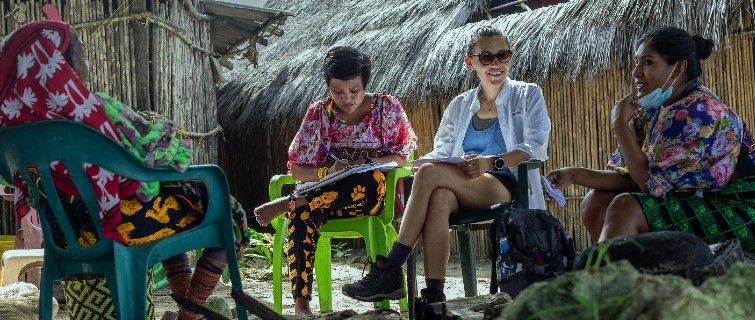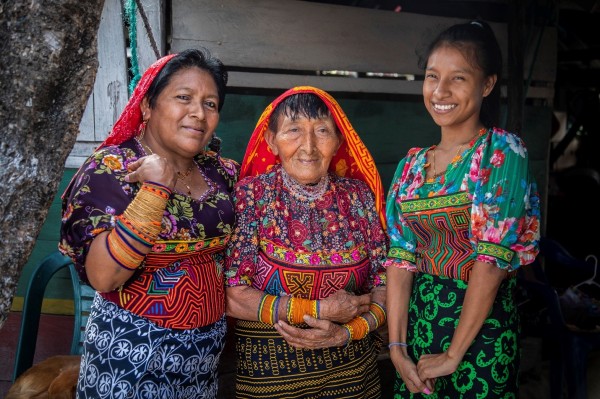
In her Georgetown doctoral thesis, Tahina Montoya (G’23) turns to more than 150 years of feminist theory to study the Guna women of Panama and the intricately-sewn garments, called Molas, that are central to their identity. Yet it is a fitting irony—and one Montoya no doubt appreciates—that the Guna would never describe themselves in the context of feminism, or, indeed, any of the other isms derived from Western sources.
“They’re not about labels,” Montoya says. “They explicitly made it very clear to me: ‘Do not impose your Western labels on us,’ which I admire. Think of how we, as Western society, could benefit if we didn’t judge people so much for who they are, what they wear, who they love, but if we were more inclined to focus on what they contribute to the community.”
An Interdisciplinary Study

A Major in the Air Force Reserves, Montoya is writing her dissertation, “Woven Identities: The Women Behind the Molas,” for Georgetown’s Doctor of Liberal Studies program. Unlike many Ph.D. programs, the DLS is designed for working professionals. It is part-time or full-time, interdisciplinary, and broad in scope, involving a wide range of the humanities and social sciences rather than a narrow line of research.
Montoya has also benefited from another aspect of the DLS degree. While the program is housed in the School of Continuing Studies, doctoral students can, with their advisor’s approval, take advantage of the wide range of programs across the university. Montoya earned a graduate certificate from the Georgetown Institute for Women, Peace and Security and later served as a Graduate Certificate Advisor. She has also co-written a policy brief (with fellow Georgetown alumna Jessica Margolis) for Women in International Security titled “A Gendered Global Fragility Act: Seizing an Opportunity for Change” and presented a paper (co-written by Marvin Dee Mathelier of Columbia University) titled “Gendered Implementation of the Global Fragility Act: A Case for Haiti” at the 2023 Conflict Research Society Annual Conference in London.
A Different Kind of Research

But it is her doctoral research with the women of Guna Yala, who live on 49 island communities off Panama’s Caribbean coast, that is closest to her heart. The Guna (pronounced Kuna) are best-known for their Molas that the women sew. And while a fair amount has been written about their artistic significance and the sophisticated way in which they are made, there is little research on their spiritual significance and what that says about the identity of Guna women.
Montoya recalls having to ask the village leaders—all men—for permission to conduct her ethnographic study in the two communities where she conducted her field work. And while each group of leaders gave their consent, it came with a stipulation: that the women, who would be the main subjects of her research, be on board with the process as well.
It’s perhaps no surprise that, over the years, much of the research on the Guna has been interpreted through a Western lens—the lens of the academics performing the studies. As a result, Montoya says, their work tends to overlook some of the ways in which Guna society is more complex and egalitarian than it may first appear.
Montoya wanted her study to be different. Her research, she wrote, “seeks to capture Guna women’s perspective on how their epistemology affects their self-identity and how this is translated through their art. Rather than make conclusions based on my research, I will be going straight to the source, Guna women, to hear their voice and get their input.”
Participating, Observing
Montoya’s dissertation describes a number of research methods she employs, including participant observation, a naturalistic approach to ethnography where the researcher enters and immerses herself in a group of people with a shared identity to gain an understanding of an activity that is meaningful to their community. This is likely to yield more authentic information than, for example, simply asking about their spiritual beliefs.
“When Tahina started this work with the Guna, she was very interested in the representation [in the Molas]. Does this mean something spiritually?” recalls Bette Jacobs, Ph.D., Montoya’s thesis advisor and a Distinguished Professor at Georgetown Law School. “You can’t really ask people that—that’s not how anybody talks. But you can learn about things like that by showing respect for the activity, having people talk about themselves. … Those things are much more embedded. Those are the conversations that Tahina has had.”
Montoya once brought her grandmother, who was visiting from Colombia, to one of the first Guna sewing workshops in Panama City. Having that family connection helped put everyone at ease and lighten the conversation.
As far as her sewing was concerned, “I was horrific,” Montoya says, adding that the Guna laughed at her sympathetically and said she sewed “like a 2-year-old.”
“They said they would hire my grandmother, but they would not hire me.”
That little joke showed Montoya that the women felt comfortable enough to tease her, knowing she would not take offense. It was a playful atmosphere, and it showed that they were becoming close.
A Trip to the Underworld
Like the women who make them, each Mola is unique. The ones sold to tourists may be relatively simple—or as simple as any handsewn, multi-layered garment can be. But the ones that have personal significance for the maker and wearer are unique and more complex, just as individuals themselves are unique and complex.
The Guna believe in three Gods, one of whom, Giggadiryai, traveled to the underworld, where she saw the designs on which the Molas are based. She brought them back to the world and taught the Guna women to sew. Just as the Molas are made from layered fabric, so are the Guna people themselves, the first “layer” being the amniotic sac, which presents a design on the baby when it is born. This design reveals much about the child’s personality, including its protective animal, and the animals it needs to fear.
From there, experiences are laid upon one another as the child grows up, and these experiences are reflected in the layers of the Molas. While there is a general consensus that Molas with more layers and colors are more complex, there are no “good” Molas or poorly rendered ones—ones that are deemed richer or more beautiful and others that are considered less so. Rather, says Montoya, the Guna see the garments as deeply personal representations of the women who make and wear them, and, as such, any attempt to compare them would be pointless.
“It always came back to community and working together,” Montoya says. “It seems like such a basic concept. As a Western society, we presumably have so many resources available to us, and we still can’t grasp the most basic of concepts like, ‘Let’s not judge people as long as they contribute to society. Let’s work together to resolve issues’—the most basic of concepts you would think that, as a Western society, we should have mastered, but that we can’t quite seem to grasp.”
